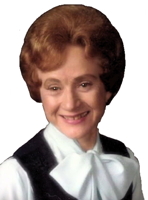
|
The Society of Folk Dance Historians (SFDH)
National Folk Organization:
[
Home |
About |
Encyclopedia | CLICK AN IMAGE TO ENLARGE |

|
 What would make a person even dream of founding a National Folk Organization of the USA?
What would make a person even dream of founding a National Folk Organization of the USA?
The National Folk Organization was formed in 1986 by Vytautas F. Beliajus, Mary Bee Jensen, George Frandsen, and L. DeWayne Young.
An organization would be established that could answer the questions I had had over the years in developing a successful program (the Brigham Young University International Folk Dancers). My experiences went full circle, from beginning folk dance classes to performance, from national tours to international tours, and during this process future teachers were being trained so they could carry on with the same type of programs.
The National Folk Organization is the tool to network information and answers for the following questions to make folk dance a more popular and enjoyable field, whether educationally, recreationally or as performance companies.
Where do we get the educational information to feed into making a successful program of internatioal folk dance? Where do we find recognized authorities with answers to our questions? Where do we locate folk dances and music covering beginning, recreational, intermediate, advanced and performing arts material; textbooks and dance descriptions; folk dance camps; choreographies; costuming; American folk dance research materials; USA and international contacts; international folk dance festivals; scheduling tours, travel programming, educational classes for countries/states visited; proper dress and protocol; cultural programs of the countries?
Are you sure the hands are on the waist? Are the fingers forward or backward? Is that kick supposed to be high or low? Is that sash tied on the right or left side? Simple questions, but they all had to have an answer! Why should we not offer all this background educational material upon request?
There are many people in the United States working with recreational groups, educational programs and, of course, the performing aspects of folk dancing. The National Folk Organization has the ability to be a source network that can make life easier for the dance leaders with answers that to us, now, seem simple, but at one time seemed insurmountable.
The National Folk Organization's first advisory committee (1986), under the capable leadership of Vyts F. Beliajus as chairman, included leaders whose fields of accomplishments acknowledged the success of the folk dance area in the USA: Randal Boothe, Dr. Clinton Border, Carol Campbell, Ethel Capps, Betty Casey, Enid Cooke, Elsie Dunin, Alexander P. Durtka, Jr., Festival of Nations, JoAnn Gibbs, Margie R. Hanson, Michael and Mary Ann Herman, the International Institute of Minnesota, Clayne Jensen, Nicholas Jordanoff, Walter Kolar, Jack Kukuk, Beresford Menagh, Harry W. Morgan, Scott Nagel, Dick Oakes, Delynne Peay, Anthony Shay, Virginia Topitzes, and Clark and Elaine Weismann.
We need this leadership as consultants in an organization that can service the needs of the individual and organization. With the changing world of today we need to take our place in the National Folk Organization to enhance the educational tools to promote the folk dance of the United States as well as develop and better understand the ethnic talents of our immigrants.
The purpose of the National Folk Organization is to advance and preserve folk arts representing both national and local ethnic customs as they exist throughout the United States; to promote and encourage the exchange of folk dance and dance related folklore in the Americas and abroad, and to effectively network those who support these objectives.
DOCUMENTS
- Mary Bee Jensen, an article.
- National Folk Organization, an article.
- National Folk Organization Conference, an article.
- NFO News, a magazine
- Vyts Beliajus, an article.
Excerpted from Mary Bee's article in Viltis, A Magazine of Folklore and Folk Dance, Vol. 52, No. 2, June-August, 1993.
This page © 2018 by Ron Houston.
Please do not copy any part of this page without including this copyright notice.
Please do not copy small portions out of context.
Please do not copy large portions without permission from Ron Houston.